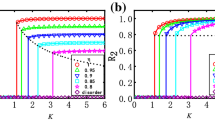Abstract
Synchronization phenomena in networks of globally coupled non-identical oscillators have been one of the key problems in nonlinear dynamics over the years. The main model used within this framework is the Kuramoto model. This model shows three main types of behavior: global synchronization, cluster synchronization including chimera states and totally incoherent behavior. We present new sufficient conditions for phase synchronization and conditions for an asynchronous mode in the finite-size Kuramoto model. In order to find these conditions for constant and time varying frequency mismatch, we propose a simple method of comparison which allows one to obtain an explicit estimate of the phase synchronization range. Theoretical results are supported by numerical simulations.
Similar content being viewed by others
References
Winfree, A. T., Biolopgical Rhythms and the Behavior of Coupled Oscillators, J. Theoret. Biol., 1967, vol. 16, pp. 15–42.
Kuramoto, Y., Chemical Oscillations, Waves and Turbulence, Berlin: Springer, 1984.
Kuramoto, Y., Self-Entrainment of a Population of Coupled Non-Linear Oscillators, in Internat. Symp. on Mathematical Problems in Theoretical Physics (Kyoto University, Kyoto (Japan), January 23–29, 1975), H. Araki (Ed.), Lect. Notes Phys., vol. 39, New York: Springer, 1975, pp. 420–422.
Michaels, D.C., Matyas, E.P., and Jalife, J., Mechanisms of Sinoatrial Pacemaker Synchronization: A New Hypothesis, Circ. Res., 1987, vol. 61, no. 5, pp. 704–714.
Brown, E., Holmes, P., and Moehlis, J., Globally Coupled Oscillator Networks, in Perspectives and Problems in Nonlinear Science: A Celebratory Volume in Honor of Larry Sirovich, E. Kaplan, J. E. Marsden, K.R. Sreenivasan (Eds.), New York: Springer, 2003, pp. 183–215.
Kopell, N. and Ermentrout, G. B., Coupled Oscillators and the Design of Central Pattern Generators, Math. Biosci., 1988, vol. 90, pp. 87–109.
Wiesenfeldt, K., Colet, P., and Strogatz, S., Frequency Locking in Josephson Junction Arrays: Connection with the Kuramoto Model, Phys. Rev. E, 1998, vol. 57, pp. 1563–1567.
Neda, Z., Ravasz, E., Vicsek, T., Brecht, Y., Barabasi, A.-L., Physics of the Rhythmic Applause, Phys. Rev. E, 2000, vol. 61, pp. 6987–6992.
Strogatz, S.H., Abrams, D.M., McRobie, A., Eckhardt, B., Ott, E., Theoretical Mechanics: Crowd Synchrony on the Millenium Bridge, Nature, 2005, vol. 438(70640), pp. 43–44.
Kozyrev, G., Vladimirov, A. G., and Mandel, P., Global Coupling with the Time Delay in an Array of Semiconductor Lasers, Phys. Rev. Lett., 2000, vol. 85, no. 18, pp. 3809–3812.
York, R.A. and Compton, R. C., Quasi-Optical Power Combining Using Mutually Synchronized Oscillator Arrays, IEEE Trans. Automat. Contr., 2012, vol. 57, no. 4, pp. 920–935.
Dorfler, F. and Bullo, F., Synchronization in Complex Networks of Phase Oscillators: A Survey, Automatica, 2014, vol. 50, no. 6, pp. 1539–1564.
Acebron, J. A., Bonilla, L. L., Vicente, C. J.P., Ritort, F., and Spigler, R., The Kuramoto Model: A Simple Paradigm for Synchronization Phenomena, Rev. Modern Phys., 2005, vol. 77, no. 1, pp. 137–185.
Gupta, Sh., Campa, A., and Ruffo, S., Kuramoto Model of Synchronization: Equilibrium and Nonequilibrium Aspects, J. Stat. Mech. Theory Exp., 2014, no. 8, R08001, 61 pp.
Aeyels, D. and Rogge, J.A., Existence of Partial Entrainment and Stability of Phase Locking Behavior of Coupled Oscillators, Progr. Theor. Exp. Phys., 2004, vol. 112, no. 6, pp. 921–942.
Mirollo, R.E. and Strogatz, S.H., The Spectrum of the Partially Locked State of the Kuramoto Model of Coupled Oscillators, Phys. D, 2005, vol. 205, nos. 1–4, pp. 249–266.
Verwoerd, M. and Mason, O., Global Phase-Locking in Finite Populations of Phase-Coupled Oscillators, SIAM J. Appl. Dyn. Syst., 2008, vol. 7, no. 1, pp. 134–160.
Jadbabaie, A., Motee, N., and Barahona, N., On the Stability of the Kuramoto Model of Coupled Oscillators, in Proc. of the American Control Conference (Boston,Mass., June 30 2004–July 2, 2004): Vol. 5, pp. 4296–4301.
Author information
Authors and Affiliations
Corresponding author
Rights and permissions
About this article
Cite this article
Belykh, V.N., Petrov, V.S. & Osipov, G.V. Dynamics of the finite-dimensional Kuramoto model: Global and cluster synchronization. Regul. Chaot. Dyn. 20, 37–48 (2015). https://doi.org/10.1134/S1560354715010037
Received:
Accepted:
Published:
Issue Date:
DOI: https://doi.org/10.1134/S1560354715010037




